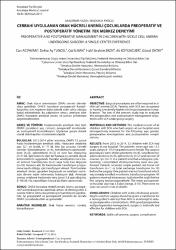CERRAHİ UYGULANAN ORAK HÜCRELİ ANEMİLİ ÇOCUKLARDA PREOPERATİF VE POSTOPERATİF YÖNETİM: TEK MERKEZ DENEYİMİ
Abstract
AMAÇ: Orak hücre anemisinde (OHA) cerrahi işlemler sıkça gereklidir. OHA’li hastaların postoperatif kompli-kasyonlar için nispeten daha yüksek riske sahip olduğu kabul edilmektedir. Bu çalışmanın amacı, ameliyat olan OHA’lı hastaların ameliyat öncesi ve sonrası yönetimini değerlendirmektir. GEREÇ VE YÖNTEM: Hastanemizde ameliyat olan tüm OHA’li çocukların yaş, cinsiyet, preoperatif incelemeler ve postoperatif komplikasyon bilgilerine geriye dönük olarak tıbbi kayıtları incelenerek ulaşıldı. BULGULAR: 2012-2014 yılları arasında, OHA’li 12 çocuk hasta hastanemizde ameliyat oldu. Hastaların ortalama yaşı 12.1 yıl (aralık, 6–17) idi. Beşi kız çocuktu. Cerrahi işlemler kolesistektomi (n=6), tonsillektomi/adenoidek-tomi (n=3), splenektomi (n=2) ve over kist eksizyonu (n=1) idi. Splenektomi olan bir hastaya eş zamanlı olarak kolesistektomi uygulandı. Hastalar ameliyattan önce ba-sit eritrosit transfüzyonu (n=1) veya total kan değişimi (n=10) tedavisi aldı. Bir hasta kronik transfüzyon progra-mına kayıtlı olduğu için transfüzyon almadı. Tüm hastalar ameliyat öncesi geceden başlayarak ve ameliyat sonra-sıda devam eden intravenöz hidrasyon aldı. Ameliyat sonrası ortalama hastanede kalış süresi 5,3 gün (dağılım, 3–10) idi. Hiç vazooklüziv kriz ya da ölüm saptanmadı. SONUÇ: OHA’lı hastalara elektif cerrahi öncesi, postope-ratif komplikasyonları azaltmak amacı ile Hemoglobin S oranını %40’ın altına düşürmek için transfüzyon yapılma-lıdır. İyi preoperatif ve postoperatif yönetim ile cerrahi OHA’lı çocuklarda etkili ve güvenlidir. OBJECTIVE: Surgical procedures are often required in si-ckle cell anemia (SCA). Patients with SCA are recognized as having a relatively higher risk for postoperative comp-lications. The aim of the present study was to evaluate the preoperative and postoperative management of pa-tients with SCA undergoing surgery. MATERIALS AND METHODS: The medical records of all children with SCA who had surgery at our hospital were retrospectively reviewed for the following: age, gender, preoperative investigations, and postoperative compli-cations. RESULTS: From 2012 to 2014, 12 children with SCA had surgery at our hospital. The patients’ mean age was 12.1 years (range, 6–17). Five patients were female. The surgical procedures were cholecystectomy (n=6), tonsillectomy/ adenoidectomy (n=3), splenectomy (n=2) and excision of ovarian cyst (n=1). In a patient who had undergone sple-nectomy, concomitant cholecystectomy were also per-formed. Patients received simple packed red blood cell transfusion (n=1) or total exchange transfusion (n=10) before the surgery. One patient was not transfused which was already enrolled in a chronic transfusion program. All patients received intravenous hydration the night before the surgery and postoperatively. The mean postoperati-ve hospital stay was 5.3 days (range, 3-10). There were no vaso-occlusive crises or deaths. CONCLUSIONS: Children with sickle cell disease presen-ting for elective surgery should be given a transfusion for a hemoglobin S ratio less than 40% in an attempt to redu-ce postoperative complications. With good preoperative and postoperative management, surgery is both safe and effective for children with SCA
















